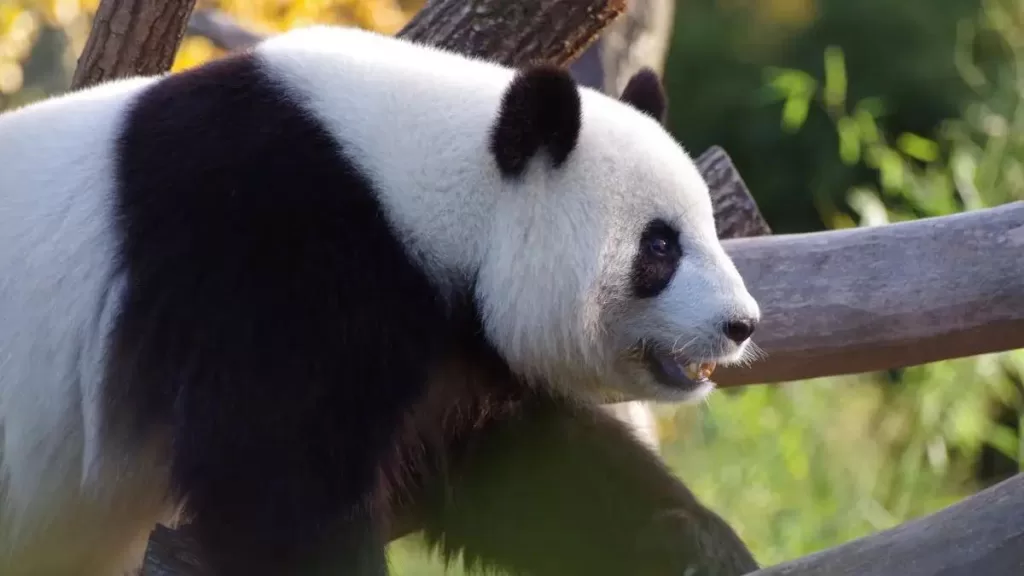The giant panda, an iconic symbol of wildlife conservation, is renowned for its distinctive appearance and unique adaptations that have evolved to support its bamboo-centric diet. Characterized by its stout body, round head, and short tail, the giant panda’s physical traits are as fascinating as they are functional. With its striking black-and-white fur and specialized features, including a pseudo-thumb for gripping bamboo and a unique facial structure that aids in vision management, the giant panda is a remarkable example of evolutionary adaptation. Understanding these characteristics provides insight into how this beloved species has adapted to its environment and ensures its continued survival in the wild.
Body Size and Color
The giant panda is known for its stout build, with a round head and a relatively short tail. Wild giant pandas typically weigh between 60 and 73 kilograms, while those in captivity generally weigh between 80 and 125 kilograms, with the heaviest individuals reaching up to 180 kilograms. Captive pandas tend to be heavier, with males usually slightly larger than females. Giant pandas have a shoulder height ranging from 650 to 750 millimeters, a hip height from 640 to 650 millimeters, and a body length that generally falls between 1200 and 1800 millimeters.
Giant pandas are easily recognizable by their distinctive black-and-white coloration. Their fur is characterized by a clear black-and-white pattern, though the black is not pure black and the white is not pure white. Instead, the black fur has a tinge of brown, and the white fur has a hint of yellow. Pandas from the Qinling Mountains in Shaanxi are generally larger, with coarser fur and a slightly brownish belly, while those from the Min Mountains have smaller bodies, finer fur, and less noticeable brown on their bellies. The black-and-white appearance of giant pandas provides effective camouflage in their forested environments and snowy habitats, serving as a form of concealment as well as a warning color.
Fur Characteristics
Giant panda fur is thick and coarse, composed of both guard hairs and underfur. The inner layer of fur is dense with a thick pith, while the outer layer is rich in oils, providing excellent moisture resistance and insulation against the cold. The fur is relatively stiff and elastic, with an underlayer of soft, insulating fur. This fur is well-suited to the pandas’ cold environments, allowing them to live comfortably in snowy regions. Depending on the panda’s individual condition, they undergo molting at different times of the year.
Facial Features
Giant pandas have naturally poor eyesight and prominent black eye patches. These eye patches function similarly to sunglasses, reducing the amount of light entering the eyes and absorbing harmful ultraviolet rays. During the summer, pandas often rest on tree tops where sunlight is intense. In the morning, when they wake up, the light at the top of the tree is strong, while the light on the ground is weaker. This is similar to how people need sunglasses to see clearly when moving from bright sunlight to a darker area. The black eye patches help pandas manage strong light exposure, protecting their eyes and allowing them to safely assess their surroundings before descending from the trees. In winter, the reflection of sunlight off the snow can also irritate their eyes; the eye patches help shield their eyes from this glare.
Teeth and Adaptations
Giant pandas have undergone significant changes in their teeth over time to better chew bamboo. Modern pandas have broad molars with numerous enamel ridges and peaks on the chewing surface. Although they retain the canine teeth of their carnivorous ancestors, these have become progressively blunt due to reduced use. The adaptation of their teeth reflects their shift from a diet of meat and omnivorous food to a specialized diet primarily consisting of bamboo.
The “Sixth Finger” Secret
Giant pandas belong to the order Carnivora due to their digestive system, though they primarily consume bamboo. While they once had five distinct fingers, an evolutionary adaptation has resulted in the development of an additional “finger” on their front paws. This “sixth finger” appears like an extra digit to the naked eye but is actually a modified wrist bone. This adaptation, known as a “pseudo-thumb,” is crucial for grasping bamboo.
The wrist bone, often referred to as a “bone” though it lacks actual bone structure, is a fleshy pad that does not grow nails. Despite this, it is as flexible as a thumb and can work in conjunction with the panda’s five actual fingers to hold bamboo effectively. This adaptation is relatively rare among animals and reflects an evolutionary advantage that aids pandas in obtaining and manipulating their primary food source—bamboo.
Tail Characteristics
The tail of the giant panda is white and quite short. There is a hairless area around the anal region with a high concentration of glands. The rest of the tail is covered in fluffy, soft fur. The tail generally lies close to the body, serving as a protective cover for the glandular and anal areas. When the tail glands, anal glands, or external genitalia secrete substances, the panda can use its tail as a brush to mark its territory and communicate with other pandas.
In summary, the giant panda’s physical characteristics are highly adapted to its environment and lifestyle. From its distinctive coloration and fur, which provide camouflage and insulation, to its unique adaptations such as the “sixth finger” and specialized teeth, every feature of the giant panda plays a crucial role in its survival and daily activities.




